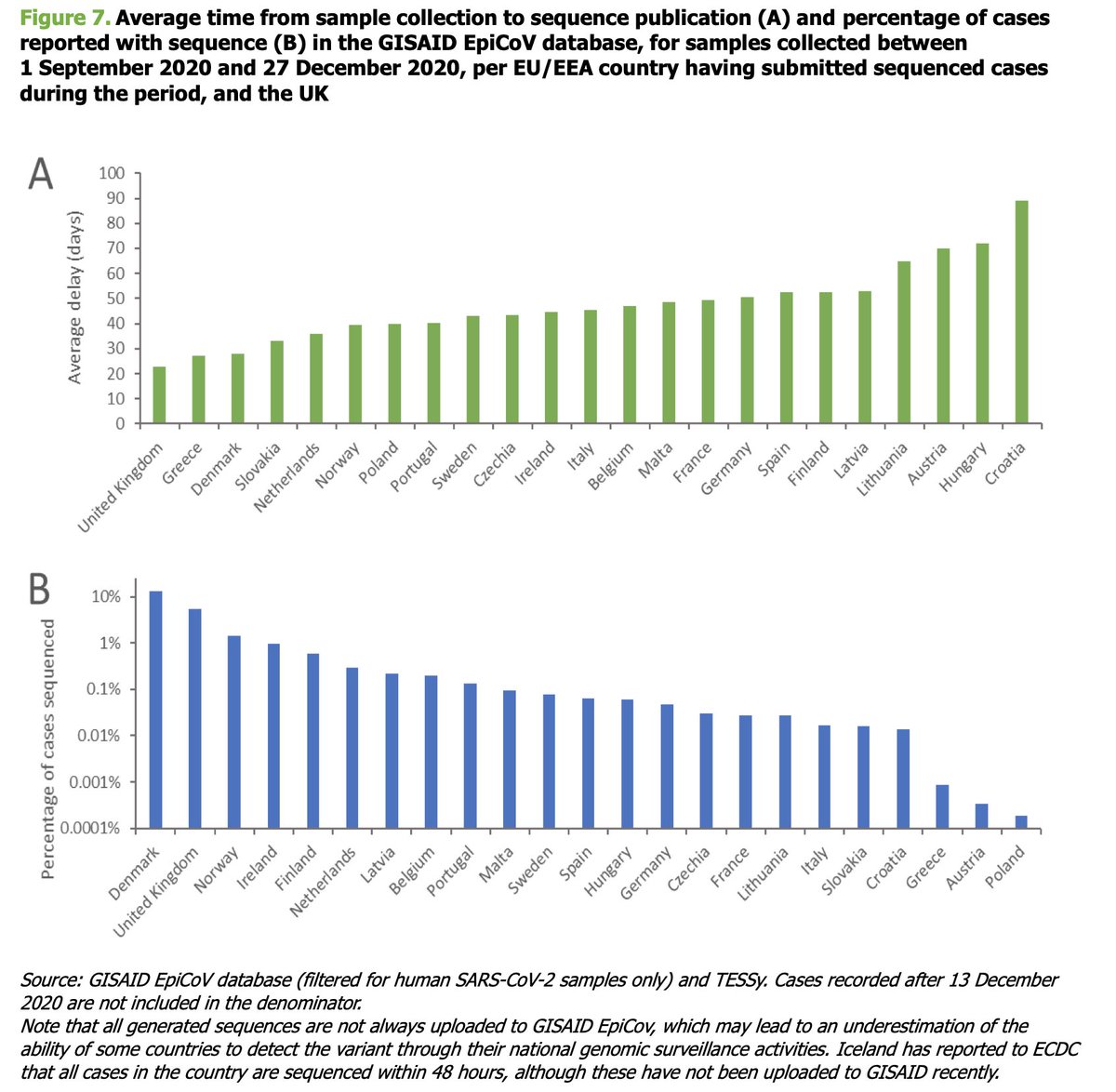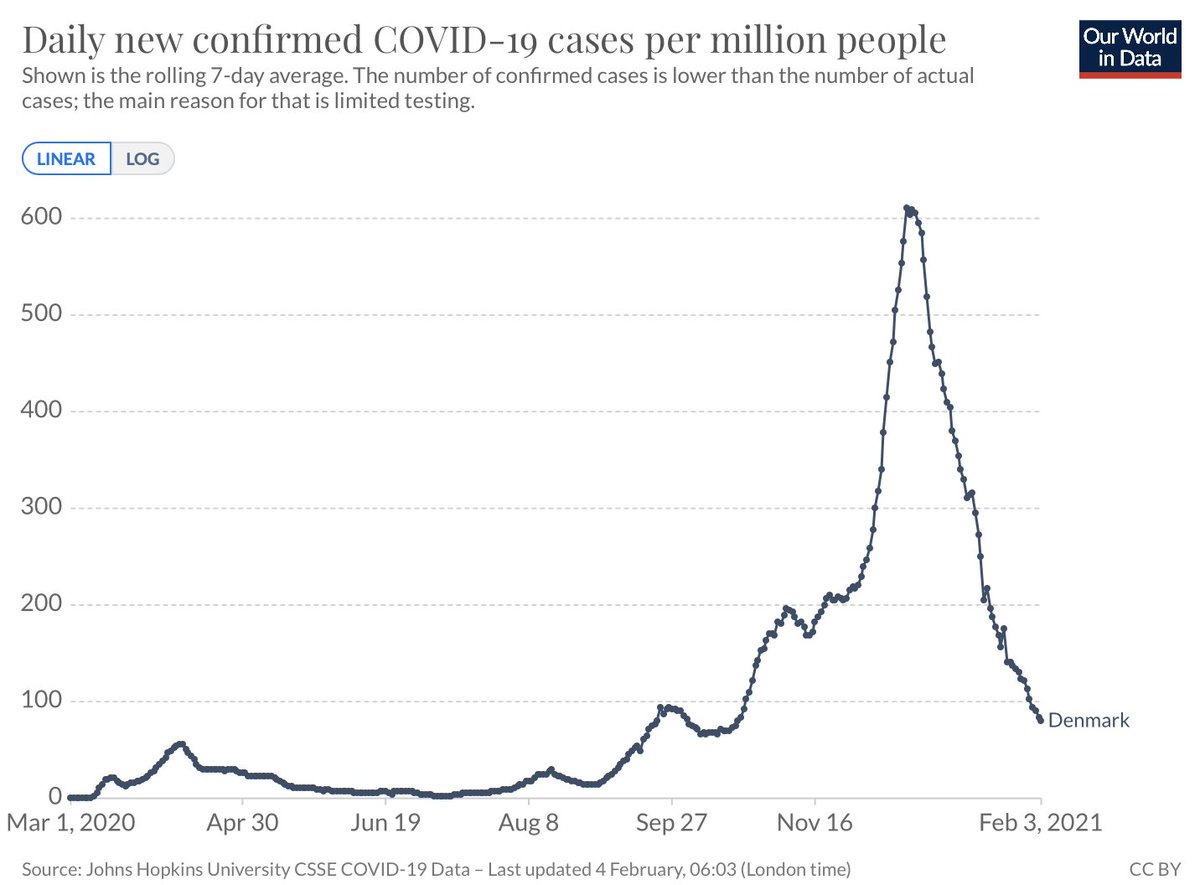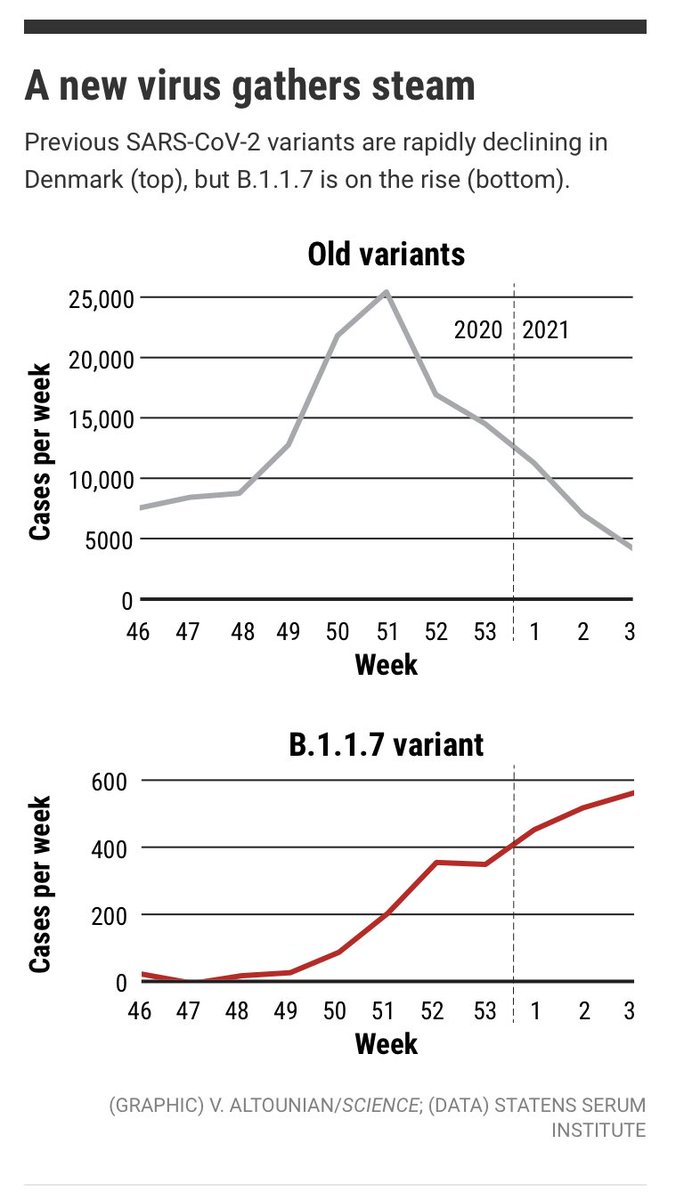I‘m struck that it still hasn’t sunk in how much #b117 may change the course of this pandemic.
The initial shock about it being more transmissible seems to have worn off. But we are barely beginning to see its real-world impact.
A story: https://www.sciencemag.org/news/2021/02/danish-scientists-see-tough-times-ahead-they-watch-more-contagious-covid-19-virus-surge
And a thread
The initial shock about it being more transmissible seems to have worn off. But we are barely beginning to see its real-world impact.
A story: https://www.sciencemag.org/news/2021/02/danish-scientists-see-tough-times-ahead-they-watch-more-contagious-covid-19-virus-surge
And a thread
After #b117 was identified in England and seemed to be taking off there, many people like me started looking at Denmark for clues.
Why Denmark? It sequences a lot! Here is a graph from @ECDC_EU from late December showing EU sequencing (look at B and note that it’s a log-scale):
Why Denmark? It sequences a lot! Here is a graph from @ECDC_EU from late December showing EU sequencing (look at B and note that it’s a log-scale):
Denmark has actually massively scaled-up its sequencing since then.
@MadsAlbertsen85 and his team, who have basically been doing all the sequencing for the whole country, are now getting close to 70% which is about as much as is possible (30% have low virus concentrations).
@MadsAlbertsen85 and his team, who have basically been doing all the sequencing for the whole country, are now getting close to 70% which is about as much as is possible (30% have low virus concentrations).
So what were people like me looking for?
At first, whether #b117 would spread in Denmark too, confirming it is more transmissible. (It is.)
But also to watch in real-time what happens to the new variant as a country tries to take aggressive action.
At first, whether #b117 would spread in Denmark too, confirming it is more transmissible. (It is.)
But also to watch in real-time what happens to the new variant as a country tries to take aggressive action.
The graph of cases in Denmark looks great.
But you have to realize it shows a combination of two epidemics: a rapidly declining one of #sarscov2 and a slowly increasing one of #b117.
We tried to show in the second graphic (needed different y axes).
But you have to realize it shows a combination of two epidemics: a rapidly declining one of #sarscov2 and a slowly increasing one of #b117.
We tried to show in the second graphic (needed different y axes).
At some point this month, #b117 is likely to take over and the rapidly declining outbreak may then become a slowly growing one.
In the middle of a fairly strict lockdown.
As Camilla Holten Moller of @SSI_dk told me: "this is the calm before the storm"
In the middle of a fairly strict lockdown.
As Camilla Holten Moller of @SSI_dk told me: "this is the calm before the storm"
It all depends on how far down Denmark can push the reproduction number R.
Latest estimates for R were:
0.78 overall and
1.07 for #b117
(new estimates expected today)
You can see the scenarios, that @SSI_dk estimated for different Rs in this report: https://covid19.ssi.dk/-/media/cdn/files/estimerede-scenarier-for-udviklingen-i-cluster-b117-270120212.pdf
Latest estimates for R were:
0.78 overall and
1.07 for #b117
(new estimates expected today)
You can see the scenarios, that @SSI_dk estimated for different Rs in this report: https://covid19.ssi.dk/-/media/cdn/files/estimerede-scenarier-for-udviklingen-i-cluster-b117-270120212.pdf
It‘s like a sink with two faucets: one wide open, one dripping. We are closing the open one, but it seems very hard to stop the other one dripping. And that dripping alone is still enough to make the sink overflow.
(Of course it’s not really a constant drip, it‘s increasing!)
(Of course it’s not really a constant drip, it‘s increasing!)
There are still things that a country like Denmark can do:
It could improve quarantine and isolation for instance.
As @M_B_Petersen
told me, the data suggests
50% of close contacts do not isolate and
15% of people tested positive.
It could improve quarantine and isolation for instance.
As @M_B_Petersen
told me, the data suggests
50% of close contacts do not isolate and
15% of people tested positive.
Pushing down the other #sarscov2 cases probably already helps, because it allows contract tracers etc. to concentrate on #b117 cases.
Rules could still be tightened, but as @M_B_Petersen told me social interaction between Danes is already as low as it has been in this pandemic.
Rules could still be tightened, but as @M_B_Petersen told me social interaction between Danes is already as low as it has been in this pandemic.
Denmark should aim for #zerocovid, says @K_G_Andersen. The UK seems to have suppressed the R of #b117 below 1, he says. "“It can be done, but it requires a tremendous amount of effort.”
If Denmark manages it, they should “follow the trajectory all the way down”, he says.
If Denmark manages it, they should “follow the trajectory all the way down”, he says.
The alternative?
Slow #b117 down as much as possible, while vaccinating the most vulnerable as fast as possible and hoping warmer weather will help too.
Question is: What then? Open up and treat this like the flu? What about #longcovid?
Slow #b117 down as much as possible, while vaccinating the most vulnerable as fast as possible and hoping warmer weather will help too.
Question is: What then? Open up and treat this like the flu? What about #longcovid?
Point is:
#B117 has narrowed the options in Denmark and many other places (they just don’t see it yet).
Even with strict measures it is hard to reduce #B117 numbers.
It acts almost as a ratchet. It’s easy to have numbers go up, very hard to bring them down.
#B117 has narrowed the options in Denmark and many other places (they just don’t see it yet).
Even with strict measures it is hard to reduce #B117 numbers.
It acts almost as a ratchet. It’s easy to have numbers go up, very hard to bring them down.

 Read on Twitter
Read on Twitter





